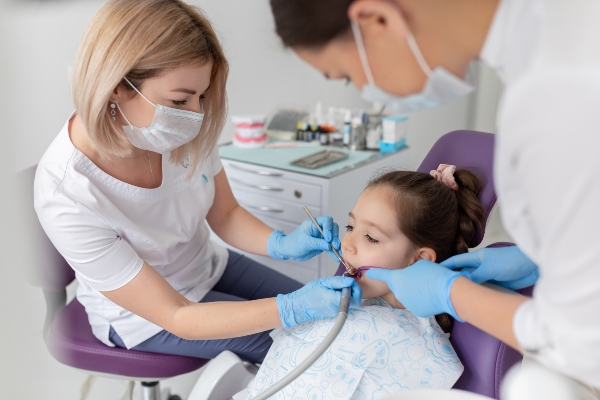Phase 1 Orthodontics from a Dentist for Kids

A dentist for kids might recommend phase 1 orthodontics if they detect your child is developing abnormalities with their teeth alignment. Phase 1 orthodontics creates a functional bite and straightens the child’s teeth. The treatment helps to create a healthy foundation for normal jaw and teeth development.
The premature or late loss of baby teeth can lead to teeth alignment issues. Baby teeth serve as space holders, keeping space for permanent teeth. Such issues, along with bite alignment problems like crowded teeth, crossbites, underbites, and overbites, can be addressed early on with phase 1 orthodontics.
What to expect when a pediatric dentist recommends phase 1 orthodontics
Phase 1 orthodontic treatment, also called early interceptive treatment, refers to orthodontic treatments that are performed on children before all of their permanent teeth erupt. These treatments are typically done between the ages of six and ten. A dentist typically recommends these treatments for kids when they detect a risk of developing moderate to severe orthodontic issues and determine that waiting can worsen things. Phase 1 orthodontic treatment is typically recommended when the pediatric dentist is sure they can make a significant difference in the development of the child’s bite.
The primary objective of phase 1 orthodontic treatment is to ensure there is enough room for all of the child’s teeth, reducing the risk of overcrowding, which leads to crooked teeth and other alignment issues. These treatments can also correct abnormalities in the child’s jaw and bite development.
Early correction of orthodontic issues reduces the risk of dental trauma. It also reduces the need to extract one or more of the child’s permanent teeth in the future to make more space for the rest of their teeth. Children with abnormalities in their bite who do not get phase 1 orthodontic treatment are significantly more likely to wear braces later in life.
Treatment times for early interceptive treatments are typically somewhere between 9 to 18 months. Children often wear retainers after these treatments to prevent their teeth from shifting back to their original positions.
Some of the appliances a dentist for kids might recommend for phase 1 orthodontics include:
- Headgear
- Space maintainers
- Specialized retainers
- Limited phase braces
- Expansion appliances
- Functional appliances
Phase 2 orthodontics
These are the teeth straightening and bite correcting treatments most people are familiar with. Phase 2 starts when braces are placed on an entire dental arc of teeth. They correct a wide range of issues like spaces between teeth, misaligned teeth, underbites, and overbites. Phase 2 orthodontics typically starts around the age of 11. Treatments can last up to 20 months, and patients typically have to wear a retainer after. Braces are the most commonly used appliances for phase 2 orthodontics, but clear aligners can also be used if the child is disciplined enough to keep up with them.
Protect your child’s bite
Phase 1 orthodontics helps to prevent major orthodontic issues from developing. Call or visit our Richmond clinic to set up an appointment with our pediatric dentist.
Request an appointment here: https://www.grandparkwaypediatricdental.com or call Grand Parkway Pediatric Dental at (832) 579-0960 for an appointment in our Richmond office.
Check out what others are saying about our keyword services on Yelp: Read our Yelp reviews.
Recent Posts
Dental fillings for kids can be nerve-wracking for some kids, likely due to the necessary tools. While we aim to make this simple process as smooth and painless as possible, we need your help. Getting a firm grasp on what your kids can expect during this procedure and how to prevent a future need for…
Getting dental fillings for kids can help improve your child’s dental health. It can restore the affected teeth and relieve your child’s pain. Understanding the process can help you prepare your child for the next appointment. Here are the details on what parents like you must know about dental fillings for kids.The dentist will discuss…
Child teeth whitening can make a significant difference in a kid’s self-esteem, especially as they grow older and become more aware of their appearance. However, many parents wonder whether whitening is safe and appropriate. A pediatric dentist can tailor teeth whitening to younger patients, focusing on restoring a natural, healthy smile while protecting developing teeth…
Dental fillings for kids are often associated with different tools and instruments. It could be your child’s first dental treatment. Dental anxiety may take over the dental visit. Knowing how your pediatric dentist eases anxiety can give you peace of mind. Here are the techniques dentists use to ease your child’s anxiety and stress while…


